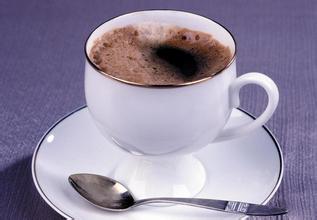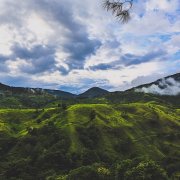All Indonesian islands produce coffee, Java coffee.
Indonesia
Coffee is produced throughout Indonesia (Indonesia), and Java occupies an extremely important position in coffee history.
In the mid-17th century, coffee trees were introduced to Indonesia by the Dutch (some official sources believe that earlier). The first coffee from Java was sold to Amsterdam in 1712. however, coffee trees on all plantations were destroyed by coffee rust in 1877 Today, only 6% or 10% of coffee beans are Arabica beans. Indonesia is the world's leading producer of Robbite coffee, producing 6.8 million bags of coffee a year, with more than half of the coffee coming from small plantations, accounting for about 90% of the total output.
The best growing areas of the archipelago are in Java, Sumatra (Blawan), Sulawesi (Sulawesi) and Flores.
Java produces exquisite aromatic coffee with relatively low acidity, delicate taste and good balance. Java coffee has better aroma and acidity than Sumatra and Sulawesi. The best plantations in Java are Blawan, Jambit, Kayumas and Pankur. Java mocha is a mixture of Java and Yemeni mocha.
Sumatra, the second largest island in the Indonesian archipelago, is the center of Indonesia's oil industry and is also famous for its rubber and timber exports. But Sumatra coffee is more eye-catching, similar to Java coffee, but slightly heavier. Coffee beans from Mandheling and Ankola are also valued, and the former is even hailed as the world's fullest coffee bean.
The island of Sulawesi, located between Brneo and New Guinea, is sometimes called Celebes. The coffee produced on the island is full-grained and full-scented. The best coffee beans come from Kalossi and Rantepao in the south of the island. In many brands, you might as well try Celebes Kalosi coffee.
One of the main coffee producers in New Guinea is the Sigri plantation, which has the same overall style as archipelago coffee, full of particles and good balance.
On the whole, Indonesian coffee has a strong flavor, mellow taste, slightly syrup flavor and excellent acidity. Its two main export markets are Germany and Japan. This reflects the excellent quality of the coffee from the side. what attracts consumers is the unique quality of its Arabica beans. You can add milk or cream to high-quality Indonesian coffee without worrying about affecting its taste. Indonesian coffee is divided into six grades, the best of which is AP. But no one is sure what these two capital letters stand for.
When ships replaced sailboats, the coffee produced in these islands faced the same problem as Indian coffee from Mysore-that is, consumers were used to coffee affected by long-distance travel, so they were reluctant to accept the taste of this "fresh" coffee. In order to solve this problem, the Indonesian government tried to copy coffee affected by long-distance travel. They stored the coffee beans for as long as a year. What is not satisfactory is that the taste of the wetted coffee is not so widely accepted that it affects the good reputation of the coffee.
However, Indonesia's "store" or "journey" coffee is still produced today. It is generally sold under the brands of "Old Government", "Old Brown" and "Old Java".
Although Indonesia produces so much admirable coffee, it is puzzling that local residents prefer Turkish-style coffee to its famous European-style coffee.
Kopi Luwah
Top coffee. The name of this coffee is KOPI LUWAK. The annual output is only about 500 pounds. Scarcity is the most expensive thing. The price of KOPI LUWAK is $300 a pound. The price may reflect its rare characteristics, while its "production" process can be described as "rare".
KOPI (Indonesian, coffee) LUWAK is produced in Sumatra, Zawa, and Sulvish and is part of the 13677 islands of Indonesia. LUWAK coffee is as expensive as gold and silver is not an infinite scenery on a fake island, but because of how it is produced. On these islands in Indonesia, there is a kind of marsupial civet cat, which belongs to the genus tree-borne civet. Locals hate these raccoons because they often eat the most ripe and reddest coffee fruits in coffee trees. I do not know who first thought that this kind of animal can eat, digest and defecate. Some are shameless, desperate, or simply because lazy locals pick out more complete beans wrapped in pulp slime from raccoon droppings. Perhaps it is through the fermentation of enzymes in the animal stomach that this kind of coffee bean has a unique flavor. Interestingly, this particular "production process" is not unique to the coffee industry. The rubber-like ARGAN tree is native to Morocco and produces olive-shaped fruit that can extract ARGAN oil. In Morocco, cypress people drive sheep up trees and let them eat their fruit. Then they collect sheep dung, remove the dung, and squeeze the fruit out of ARGAN oil. ARGAN oil can be used for massage, eating and aphrodisiac. It is assumed that from the beginning, Indonesian islanders have used it to avoid the pain of climbing trees and produce the most expensive coffee in the world. This coffee tastes very thick with a touch of caramel. Although the coffee beans are stale and jungle fragrance, the baked beans have a very complex aroma. Because the stomach acid and enzymes in the digestive system of raccoons are very different from the fermentation process of coffee with water, the coffee is as thick as syrup. KOPI LUWAK coffee tastes mellow and lubricated. Coffee as thick as chocolate pulp gives your tongue a long and clear aftertaste.

Important Notice :
前街咖啡 FrontStreet Coffee has moved to new addredd:
FrontStreet Coffee Address: 315,Donghua East Road,GuangZhou
Tel:020 38364473
- Prev

Expensive cat dung coffee
Filipino farmers who grow coffee once tried to kill civets because they stole coffee fruits and later found that civets could help them make a lot of money. Nowadays, for some farmers, civets are geese that lay golden eggs, so it is more comfortable to be caged. We never dreamed that we could make money from them, Rustico Montenegro told AFP. 44-year-old
- Next

The port of Mocha in Yemen is transported to the Reunion single Coffee Manor.
In 1715, the first coffee trees (about 40) were transported from the Yemeni port of Moka to La Runion, but unfortunately only two survived. By 1719, coffee plantations had flourished and sold the first coffee beans. Over the next few years, the government adopted a rigid measure: residents of the island, whether black or white, had to plant 10% a year.
Related
- Does Rose Summer choose Blue, Green or Red? Detailed explanation of Rose Summer Coffee plots and Classification in Panamanian Jade Manor
- What is the difference between the origin, producing area, processing plant, cooperative and manor of coffee beans?
- How fine does the espresso powder fit? how to grind the espresso?
- Sca coffee roasting degree color card coffee roasting degree 8 roasting color values what do you mean?
- The practice of lattes: how to make lattes at home
- Introduction to Indonesian Fine Coffee beans-- Java Coffee producing area of Indonesian Arabica Coffee
- How much will the flavor of light and medium roasted rose summer be expressed? What baking level is rose summer suitable for?
- Introduction to the characteristics of washing, sun-drying or wet-planing coffee commonly used in Mantenin, Indonesia
- Price characteristics of Arabica Coffee Bean Starbucks introduction to Manning Coffee Bean Taste producing area Variety Manor
- What is the authentic Yega flavor? What are the flavor characteristics of the really excellent Yejasuffi coffee beans?

